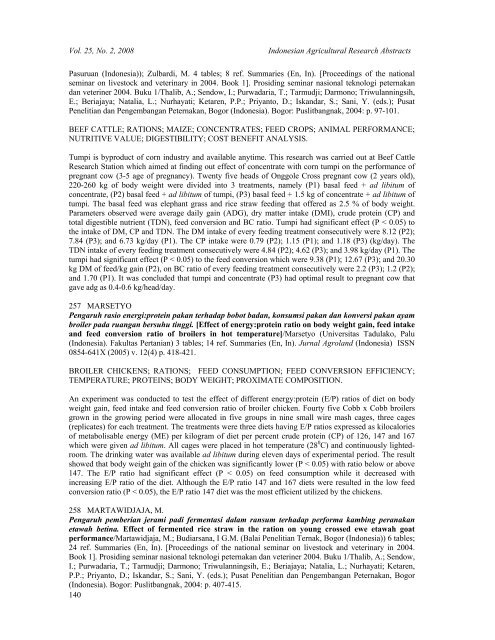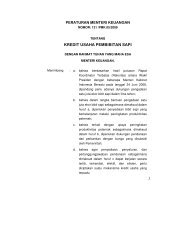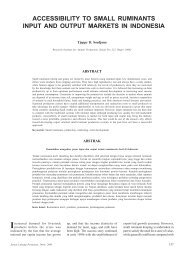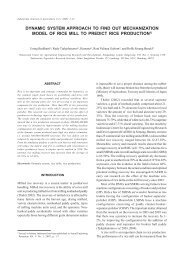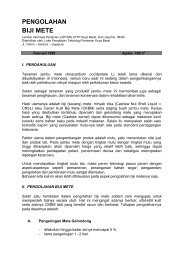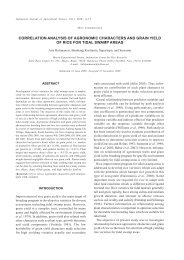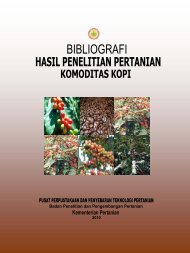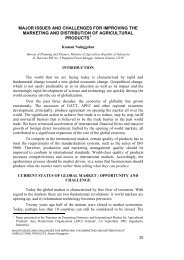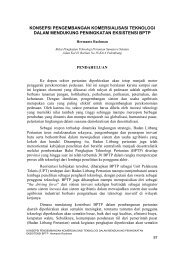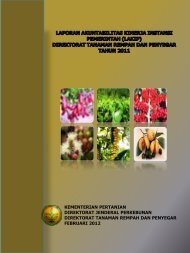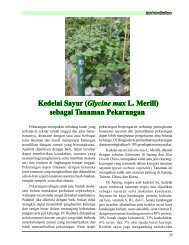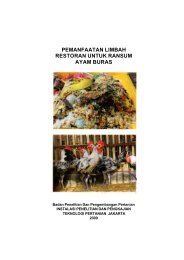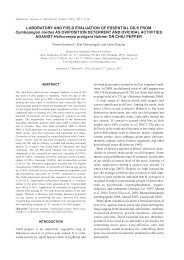<strong>Vol</strong>. 25, <strong>No</strong>. 2, <strong>2008</strong>Indonesian Agricultural Research AbstractsPasuruan (Indonesia)); Zulbardi, M. 4 tables; 8 ref. Summaries (En, In). [Proceedings of the nationalseminar on livestock and veterinary in 2004. Book 1]. Prosiding seminar nasional teknologi peternakandan veteriner 2004. Buku 1/<strong>Th</strong>alib, A.; Sendow, I.; Purwadaria, T.; Tarmudji; Darmono; Triwulanningsih,E.; Beriajaya; Natalia, L.; Nurhayati; Ketaren, P.P.; Priyanto, D.; Iskandar, S.; Sani, Y. (eds.); PusatPenelitian dan Pengembangan Peternakan, Bogor (Indonesia). Bogor: Puslitbangnak, 2004: p. 97-101.BEEF CATTLE; RATIONS; MAIZE; CONCENTRATES; FEED CROPS; ANIMAL PERFORMANCE;NUTRITIVE VALUE; DIGESTIBILITY; COST BENEFIT ANALYSIS.Tumpi is byproduct of corn industry and available anytime. <strong>Th</strong>is research was carried out at Beef CattleResearch Station which aimed at finding out effect of concentrate with corn tumpi on the performance ofpregnant cow (3-5 age of pregnancy). Twenty five heads of Onggole Cross pregnant cow (2 years old),220-260 kg of body weight were divided into 3 treatments, namely (P1) basal feed + ad libitum ofconcentrate, (P2) basal feed + ad libitum of tumpi, (P3) basal feed + 1.5 kg of concentrate + ad libitum oftumpi. <strong>Th</strong>e basal feed was elephant grass and rice straw feeding that offered as 2.5 % of body weight.Parameters observed were average daily gain (ADG), dry matter intake (DMI), crude protein (CP) andtotal digestible nutrient (TDN), feed conversion and BC ratio. Tumpi had significant effect (P < 0.05) tothe intake of DM, CP and TDN. <strong>Th</strong>e DM intake of every feeding treatment consecutively were 8.12 (P2);7.84 (P3); and 6.73 kg/day (P1). <strong>Th</strong>e CP intake were 0.79 (P2); 1.15 (P1); and 1.18 (P3) (kg/day). <strong>Th</strong>eTDN intake of every feeding treatment consecutively were 4.84 (P2); 4.62 (P3); and 3.98 kg/day (P1). <strong>Th</strong>etumpi had significant effect (P < 0.05) to the feed conversion which were 9.38 (P1); 12.67 (P3); and 20.30kg DM of feed/kg gain (P2), on BC ratio of every feeding treatment consecutively were 2.2 (P3); 1.2 (P2);and 1.70 (P1). It was concluded that tumpi and concentrate (P3) had optimal result to pregnant cow thatgave adg as 0.4-0.6 kg/head/day.257 MARSETYOPengaruh rasio energi:protein pakan terhadap bobot badan, konsumsi pakan dan konversi pakan ayambroiler pada ruangan bersuhu tinggi. [Effect of energy:protein ratio on body weight gain, feed intakeand feed conversion ratio of broilers in hot temperature]/Marsetyo (Universitas Tadulako, Palu(Indonesia). Fakultas Pertanian) 3 tables; 14 ref. Summaries (En, In). Jurnal Agroland (Indonesia) ISSN0854-641X (2005) v. 12(4) p. 418-421.BROILER CHICKENS; RATIONS; FEED CONSUMPTION; FEED CONVERSION EFFICIENCY;TEMPERATURE; PROTEINS; BODY WEIGHT; PROXIMATE COMPOSITION.An experiment was conducted to test the effect of different energy:protein (E/P) ratios of diet on bodyweight gain, feed intake and feed conversion ratio of broiler chicken. Fourty five Cobb x Cobb broilersgrown in the growing period were allocated in five groups in nine small wire mash cages, three cages(replicates) for each treatment. <strong>Th</strong>e treatments were three diets having E/P ratios expressed as kilocaloriesof metabolisable energy (ME) per kilogram of diet per percent crude protein (CP) of 126, 147 and 167which were given ad libitum. All cages were placed in hot temperature (28 0 C) and continuously lightedroom.<strong>Th</strong>e drinking water was available ad libitum during eleven days of experimental period. <strong>Th</strong>e resultshowed that body weight gain of the chicken was significantly lower (P < 0.05) with ratio below or above147. <strong>Th</strong>e E/P ratio had significant effect (P < 0.05) on feed consumption while it decreased withincreasing E/P ratio of the diet. Although the E/P ratio 147 and 167 diets were resulted in the low feedconversion ratio (P < 0.05), the E/P ratio 147 diet was the most efficient utilized by the chickens.258 MARTAWIDJAJA, M.Pengaruh pemberian jerami padi fermentasi dalam ransum terhadap performa kambing peranakanetawah betina. Effect of fermented rice straw in the ration on young crossed ewe etawah goatperformance/Martawidjaja, M.; Budiarsana, I G.M. (Balai Penelitian Ternak, Bogor (Indonesia)) 6 tables;24 ref. Summaries (En, In). [Proceedings of the national seminar on livestock and veterinary in 2004.Book 1]. Prosiding seminar nasional teknologi peternakan dan veteriner 2004. Buku 1/<strong>Th</strong>alib, A.; Sendow,I.; Purwadaria, T.; Tarmudji; Darmono; Triwulanningsih, E.; Beriajaya; Natalia, L.; Nurhayati; Ketaren,P.P.; Priyanto, D.; Iskandar, S.; Sani, Y. (eds.); Pusat Penelitian dan Pengembangan Peternakan, Bogor(Indonesia). Bogor: Puslitbangnak, 2004: p. 407-415.140
Indonesian Agricultural Research Abstracts <strong>Vol</strong>. 25, <strong>No</strong>. 2, <strong>2008</strong>GOATS; RATIONS; RICE STRAW; FERMENTATION; SILAGE; FEED CONSUMPTION; WEIGHTGAIN.<strong>Th</strong>e experiment was carried out at the Research Institute for Animal Production Ciawi, Bogor for 12weeks using 24 weaning Etawah crossed ewe. <strong>Th</strong>e goats were randomly divided into three groups, eightgoats each which was given one of three dietary treatments of R1 = 37.1% dry matter (DM) of rice strawfermented (RSF) + 62.9% DM of concentrate C1; R2 = complete feed (37.1% DM of grinding RSFgrinded + 62.9% DM of concentrate C1; and R3 = 37.1% DM of king grass + 62.9% DM of concentrateC2. <strong>Th</strong>e ration was given 3.5% of liveweight. Parameters measured were ration consumption, live weightchanges and feed conversion. <strong>Th</strong>e result showed that dry matter intake among dietary treatment groupswere not significantly different. Crude protein intake of R1 had 3.05% higher than R2. R2 had 3.52%higher than R3, while R1 and R3 were not different. <strong>Th</strong>e group receiving R1 had 2.5% and 4.64% highergross energy intakes than the groups receiving R2 and R3, respectively and R2 was 2.6% higher than R3.<strong>Th</strong>e group receiving R1 had 8.09% and 9.87% lower average NDF intake than the groups receiving R2and R3, while between the groups receiving R2 and R3 were not significantly different. <strong>Th</strong>e average dailygain (ADG) of the group receiving R1 was 29.8% significantly higher than R3 (P < 0.05) and 14.8% thanR2 (P > 0.05), while R2 was 13.0% higher than R3 (P > 0.05). Feed conversion of the group receiving R1had 11.86% and 24.35% more efficient than R2 and R3, and R2 had 14.17% more efficient than R3. <strong>Th</strong>efermented rice straw could be used as the feed replacing king grass basal diet. Feeding ungroundfermented rice straw had better effects on daily gain and feed conversion efficiency.259 MUNIER, F.F.Pertambahan bobot badan domba ekor gemuk (DEG) yang dipelihara secara intensif. Body weightgain of fat tail sheep in intensive rearing/Munier, F.F.; Bulo, D.; Saidah; Syafruddin; Boy, R.; FemmiN.F.; Husain, S. (Balai Pengkajian Teknologi Pertanian Sulawesi Tengah, Palu (Indonesia)) 1 ill., 2 tables;17 ref. Summaries (En, In). [Proceedings of the national seminar on livestock and veterinary in 2004.Book1]. Prosiding seminar nasional teknologi peternakan dan veteriner 2004. Buku 1/<strong>Th</strong>alib, A.; Sendow,I.; Purwadaria, T.; Tarmudji; Darmono; Triwulanningsih, E.; Beriajaya; Natalia, L.; Nurhayati; Ketaren,P.P.; Priyanto, D.; Iskandar, S.; Sani, Y. (eds.); Pusat Penelitian dan Pengembangan Peternakan, Bogor(Indonesia). Bogor: Puslitbangnak, 2004: p. 341-347.SHEEP; FEED CONSUMPTION; LEGUMINOSAE; RATIONS; WEIGHT GAIN; REARINGTECHNIQUES.Improving of rearing system for fat tail sheep (FTS) from semi intensive to intensive intends to increasebody weight of the FTS. <strong>Th</strong>e assessment which was to observe the effect of feed supplement on bodyweight gain of FTS in intensive rearing (in pen) was conducted in Kawatuna Village, Subdistrict of SouthPalu, Palu City, Central Sulawesi from August-December 2003. <strong>Th</strong>irty two heads of fat tail ewes with 1.0- 1.5 years old were used. <strong>Th</strong>e ewes were divided into four groups with eight heads each, one group infarmer pattern (control) and three groups for feed supplement treatment, i.e. P0 = 1.5 kg grass (withoutfeed supplement), P1 = 1.5 kg grass + 0.5 kg Gliricidia sepium + 0.2 kg rice bran, P2 = 1.5 kg grass + 0.5kg byproducts of peanut (Arachis hypogaea) + 0.2 kg rice bran, P3 = 1.5 kg grass + 0.5 kg Desmanthusvirgatus + 0.2 kg rice bran. Feed was given twice, half portion in the morning and another half portion inthe afternoon. Weighing was carried out every two weeks in the morning before feeding. <strong>Th</strong>e statisticalanalysis used Quadratic Regression by STATS VERSI 2.6 Program. Result showed that there was asignificant different (P < 0.01) on body daily weight gain. Result of Quadratic Regression test of bodydaily weight gain between P0 and P1 was significantly different (P < 0.01), P0 and P2 was notsignificantly different (P > 0.05), P0 and P3 was significantly different (P < 0.05). <strong>Th</strong>e average of finalbody weight for P0 (17.94 kg/head), P1 (23.75 kg/head), P2 (21.38 kg/head), and P3 (22.50 kg/head),respectively.260 NASER, A.Pengaruh level energi dalam ransum terhadap status faali domba lokal yang dipelihara padaketinggian tempat berbeda. [Effect of energy level in rations on physiological status of local sheepreared at different altitude]/Naser, A. (Universitas Tadulako, Palu (Indonesia). Fakultas Pertanian) 3 ill.,141
- Page 2: ISSN: 0216-3713INDONESIAN AGRICULTU
- Page 7 and 8: Indonesian Agricultural Research Ab
- Page 9 and 10: Indonesian Agricultural Research Ab
- Page 11 and 12: Indonesian Agricultural Research Ab
- Page 13 and 14: Indonesian Agricultural Research Ab
- Page 15 and 16: Indonesian Agricultural Research Ab
- Page 17 and 18: Indonesian Agricultural Research Ab
- Page 19 and 20: Indonesian Agricultural Research Ab
- Page 21 and 22: Indonesian Agricultural Research Ab
- Page 23 and 24: Indonesian Agricultural Research Ab
- Page 25 and 26: Indonesian Agricultural Research Ab
- Page 27 and 28: Indonesian Agricultural Research Ab
- Page 29 and 30: Indonesian Agricultural Research Ab
- Page 31 and 32: Indonesian Agricultural Research Ab
- Page 33 and 34: Indonesian Agricultural Research Ab
- Page 35 and 36: Indonesian Agricultural Research Ab
- Page 37 and 38: Indonesian Agricultural Research Ab
- Page 39 and 40: Indonesian Agricultural Research Ab
- Page 41 and 42: Indonesian Agricultural Research Ab
- Page 43 and 44: Indonesian Agricultural Research Ab
- Page 45 and 46: Indonesian Agricultural Research Ab
- Page 47 and 48: Indonesian Agricultural Research Ab
- Page 49: Indonesian Agricultural Research Ab
- Page 53 and 54: Indonesian Agricultural Research Ab
- Page 55 and 56: Indonesian Agricultural Research Ab
- Page 57 and 58: Indonesian Agricultural Research Ab
- Page 59 and 60: Indonesian Agricultural Research Ab
- Page 61 and 62: Indonesian Agricultural Research Ab
- Page 63 and 64: Indonesian Agricultural Research Ab
- Page 65 and 66: Indonesian Agricultural Research Ab
- Page 67 and 68: Indonesian Agricultural Research Ab
- Page 69 and 70: Indonesian Agricultural Research Ab
- Page 71 and 72: Indonesian Agricultural Research Ab
- Page 73 and 74: Indonesian Agricultural Research Ab
- Page 75 and 76: Indonesian Agricultural Research Ab
- Page 77 and 78: Indonesian Agricultural Research Ab
- Page 79 and 80: Indonesian Agricultural Research Ab
- Page 81 and 82: Vol. 25, No. 2, 2008BODY WEIGHT251,
- Page 83 and 84: Vol. 25, No. 2, 2008EVALUATION210EX
- Page 85 and 86: Vol. 25, No. 2, 2008LACTUCA SATIVA1
- Page 87 and 88: Vol. 25, No. 2, 2008PROPAGATION MAT
- Page 89 and 90: Vol. 25, No. 2, 2008VVANILLA PLANIF


